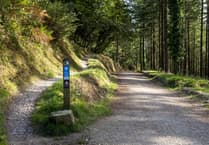THE very unpopular stinging nettles are showing their flowers around the village, but what interests me on the hedgerow when the sun is shining are the number of beetles and butterflies that pitch on the vegetation.
I spotted a Longhorn beetle making its way up the stem of a plant and was able to get a sharp picture showing its very long antennae – hence its name.
It has a black head and thorax with yellow markings, and although it can fly, it is reluctant to do so, making the insect reasonably easy to photograph.
I took a long walk of nearly three miles on the Longest Day (June 21) and I re-named it Hoverfly Day as I saw at least 300 of these delightful flies on the hedges.
There were a couple that I recognised, the Episyrphus balteatus – often called the Marmalade hoverfly – which is probably the commonest and best known of these flies, and the Epistrophe grossulariae, another large fly with a body length of around 16mm.
However, most of the host of hover flies that I saw were far too small, about 6mm to 8 mm, for me to photograph with my shaky hands.
They all feed on nectar from flowers and all these creatures learnt, over the past millions of years, that birds on the look-out for food, will never touch anything that looks like a wasp.
This is probably due to its sting or maybe its taste, so they acquired the yellow and black stripes to make them look like wasps.
I came across a lovely patch of blue Germander speedwell blooms that really stuck out from the hedge vegetation and Tutsan plants were showing their yellow flowers, but most are now producing the black berries that are poisonous, although its leaves were once used to cover cuts on the body to help the healing process.
Tutsan is a member of the St John’s Wort family.
Crab spiders are always a little difficult to spot as they are usually white.
However, when they sit on a flower, they have the ability to change their colour to blend in with the background so when a small butterfly or insect comes within reach they are quickly grabbed, paralysed and then eaten.
Obviously, they are so named because of their crab-like appearance.
We have an ornamental cherry tree in the garden and over the past couple of weeks some of the leaves have been covered with ladybird larvae.
They are black with two rows of yellow spikes on their backs and are around 8mm in length.
There were over 30 of them and I kept my eye on them as they became seven-spot ladybirds.
My sister lives in Liskeard and when she came out for lunch last week, she told us an amusing story about blackbirds.
It appears that water in the old granite cattle trough on her lawn had dried up, leaving several dry leaves in the bottom. When she looked out her kitchen window one morning she saw two blackbirds, a male and a female, perched on the trough.
Thinking that they were looking for a drink, even though there is a bird bath nearby, she picked all the leaves from the trough, threw them on the lawn and filled the trough with water.
As she watched, the female bird picked up a beak full of leaves and jumping up on the trough she dipped the leaves into the water and flew off with the mouthful.
The male did the same and they both came back and repeated the process.
Where did they take the leaves, were they for nest building we wonder?




